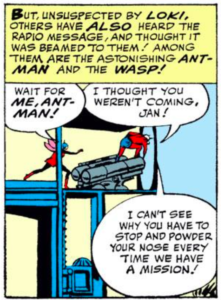And then, in Spider-Man 3, Sam Raimi changes the game. Peter Parker, constantly vilified by the public while tirelessly fighting for their safety, stands in awe of a news announcement that Spider-man will receive the key to the city. Sure enough, standing next to him at that moment is Stan Lee. In his unmistakeable raspy yet booming voice, Lee declares: “I guess one person can make a difference.” He shrugs and exits on his classic line: “Nuff said.” Lee’s Spider-Man saga has always held this idea at is core: that doing good is not always easy, but it is necessary and possible. Raimi allows Spider-Man to hear this thesis from the very person who has enacted it upon him, who has made his journey long and hard so as to prove this very point. Spider-Man 3 elevates the Lee cameo, taking a more nuanced and meta approach to the idea of having a superhero creator inhabit the world of his creation.
The Marvel Cinematic Universe begins a year after Spiderman 3, and continues, but perverts, the cameo tradition. Instead of a kind citizen, Stan Lee is now a background scumbag. In Iron Man (2008), he plays himself mistaken for Hugh Hefner, his arms wrapped around two young women while he smokes a pipe. In Thor (2011), he’s a hooligan attempting to wreck a truck by driving it while tethered to Thor’s hammer. These cameos, where the joke seems to be that the creator of a world of superheroes would exist in that world as the very opposite of an upstanding hero, often delight in having Stan Lee leer at women. In Ant-Man (2015), Lee as a bartender describes Hope Pym as “crazy stupid fine.” In Guardians of The Galaxy (2014), he grabs the arm of a young alien as Rocket Raccoon asks: “where’s your wife, old man?” The joke that Stan Lee would appear in his stories as an old chauvinist is particularly unfunny considering his culpability in the limited and reductive roles that women play in superhero stories. Women in Stan Lee stories tended to be girlfriends and wives playing supporting roles, even if, like Jean Grey, Sue Storm, and the Wasp, they had impressive powers of their own.
The film which manages to elevate the Stan Lee dirtbag cameo is (of course) Black Panther (2018). T’Challa shoots craps with Agent Ross while discussing a complex political situation, but he leaves before it’s announced that he won. Suddenly, Stan Lee walks over to the table, and grabs T’challa’s chips. “You know what? I think I’ll just take these,” Lee announces. In Black Panther, virtually all white men share this desire to take everything from Wakanda for their own. In a subtle indictment of white comic book writers penning black superheroes, Black Panther reveals Stan Lee, the creator of its eponymous hero, as just another white guy taking what isn’t his.
While most of the MCU films make Stan Lee trash, a strand of them take cues from Spider-man 3, using the presence of a creator living in his own narrative to build strange and self-aware scenes. The first very interesting one is at the end of The Avengers (2012). In a bittersweet moment after their big alien battle, the team watches a wall of screens with varying civilian reactions to the first major superhero battle. A boy skateboards in a Captain America suit, a scared couple on the news wonders what the superheroes aren’t telling them, a smiling young woman in a Hulk mask flashes peace signs. As violins swell, the monitor shows Lee, sitting at a chess table in a city park, laughing. “Superheroes? In New York? Gimme a break.” Stripped of the music and the surrounding footage, Lee’s cameo would sound like another light sweet meta-joke, but in this context it lands as a man scoffing at the idea of his own creation. Does “gimme a break?” mean that superheroes in New York are unbelievable? Unnecessary? Outdated? Either way, this criticism must fall onto Lee himself, the man who brought superheroes to New York. From the Fantastic Four to Spiderman to Daredevil and on and on, Lee built some of the most rich and lasting superhero stories, mapping all of the melodrama of human life onto grand and cosmic characters. For better and worse, he changed superheroes. The most recent MCU film, Ant Man and the Wasp (2018) feels more like a Stan Lee comic than any superhero film in a while. The intense love and humour of families wraps around the insanity of quantum realms and messages from the dead. In his cameo, a limping Lee stands above the space where his car was moments ago, before it was shrunken to atomic size. “Well,” he grumbles, “the ’60s were fun, but now I’m paying for it.”
